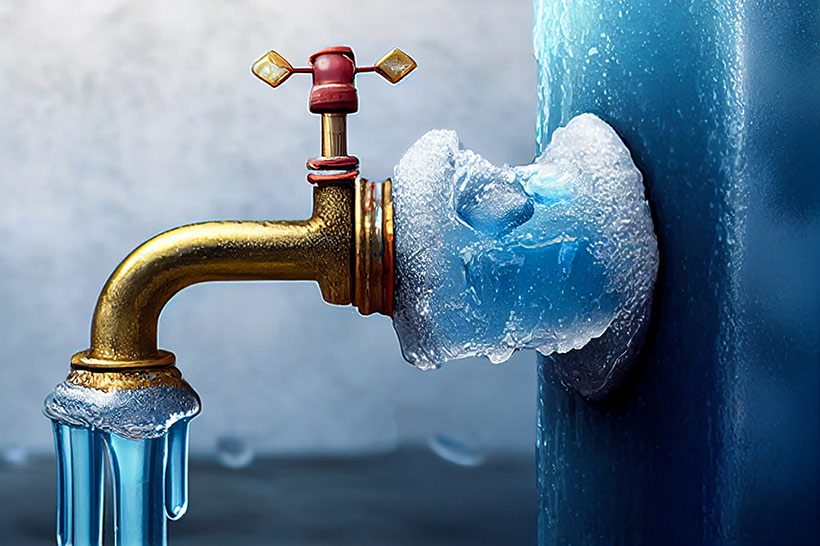Key Approaches for Preventing Frozen Plumbing in Cold Weather
Key Approaches for Preventing Frozen Plumbing in Cold Weather
Blog Article
What're your opinions about 6 Ways to Prevent Frozen Pipes?

Winter can damage your plumbing, particularly by freezing pipelines. Right here's exactly how to prevent it from occurring and what to do if it does.
Intro
As temperature levels drop, the risk of frozen pipes boosts, possibly causing expensive repair services and water damages. Comprehending how to avoid icy pipes is critical for property owners in cool environments.
Avoidance Tips
Insulating at risk pipelines
Cover pipes in insulation sleeves or utilize warm tape to safeguard them from freezing temperatures. Focus on pipes in unheated or external locations of the home.
Heating techniques
Maintain indoor areas sufficiently heated, specifically locations with plumbing. Open cupboard doors to enable cozy air to flow around pipes under sinks.
How to identify frozen pipes
Look for decreased water flow from faucets, unusual odors or noises from pipes, and visible frost on exposed pipelines.
Long-Term Solutions
Structural modifications
Take into consideration rerouting pipelines far from outside walls or unheated areas. Add added insulation to attic rooms, cellars, and crawl spaces.
Updating insulation
Invest in top notch insulation for pipelines, attics, and walls. Appropriate insulation aids keep regular temperature levels and lowers the danger of icy pipes.
Protecting Outside Pipes
Garden hoses and outdoor faucets
Detach and drain pipes yard hose pipes prior to wintertime. Install frost-proof spigots or cover outside faucets with protected caps.
Comprehending Frozen Pipes
What triggers pipelines to ice up?
Pipelines freeze when subjected to temperatures below 32 ° F (0 ° C) for prolonged durations. As water inside the pipes ices up, it expands, taxing the pipeline wall surfaces and possibly triggering them to burst.
Dangers and problems
Icy pipes can cause supply of water disturbances, building damage, and expensive repair work. Burst pipelines can flooding homes and cause comprehensive structural damage.
Signs of Frozen Pipeline
Recognizing frozen pipes early can stop them from bursting.
What to Do If Your Pipelines Freeze
Immediate actions to take
If you presume frozen pipes, maintain faucets open to ease pressure as the ice melts. Make use of a hairdryer or towels taken in warm water to thaw pipelines slowly.
Final thought
Stopping icy pipes requires proactive measures and fast responses. By recognizing the causes, signs, and preventive measures, home owners can protect their pipes during winter.
5 Ways to Prevent Frozen Pipes
Drain Outdoor Faucets and Disconnect Hoses
First, close the shut-off valve that controls the flow of water in the pipe to your outdoor faucet. Then, head outside to disconnect and drain your hose and open the outdoor faucet to allow the water to completely drain out of the line. Turn off the faucet when done. Finally, head back to the shut-off valve and drain the remaining water inside the pipe into a bucket or container. Additionally, if you have a home irrigation system, you should consider hiring an expert to clear the system of water each year.
Insulate Pipes
One of the best and most cost-effective methods for preventing frozen water pipes is to wrap your pipes with insulation. This is especially important for areas in your home that aren’t exposed to heat, such as an attic. We suggest using foam sleeves, which can typically be found at your local hardware store.
Keep Heat Running at 65
Your pipes are located inside your walls, and the temperature there is much colder than the rest of the house. To prevent your pipes from freezing, The Insurance Information Institute suggests that you keep your home heated to at least 65 degrees, even when traveling. You may want to invest in smart devices that can keep an eye on the temperature in your home while you’re away.
Leave Water Dripping
Moving water — even a small trickle — can prevent ice from forming inside your pipes. When freezing temps are imminent, start a drip of water from all faucets that serve exposed pipes. Leaving a few faucets running will also help relieve pressure inside the pipes and help prevent a rupture if the water inside freezes.
Open Cupboard Doors
Warm your kitchen and bathroom pipes by opening cupboards and vanities. You should also leave your interior doors ajar to help warm air circulate evenly throughout your home.

I hope you enjoyed reading our section on How to prepare your home plumbing for winter weather. Thanks so much for taking time to read through our piece. Sharing is caring. Helping others is fun. Thanks a lot for your time spent reading it.
Click Here To Find Out More Report this page